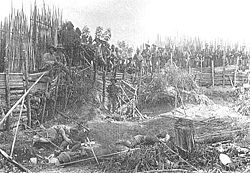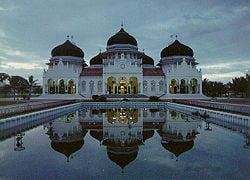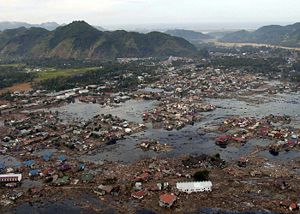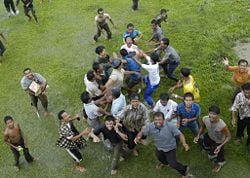Aceh
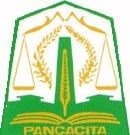
| |
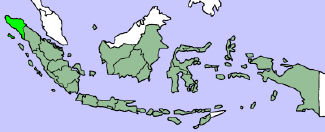 | |
| Capital | Banda Aceh |
| Governor | Dr. Ir. Mustafa Abubakar, MSi |
| Population | 4,010,860 |
| Ethnic groups | Acehnese, Gayo, Alas, Aneuk Jamee, Malay, Javanese, Kluet, Batak |
| Religion | Islam (97.6%), Christianity (1.7%), Hindu (0.08%), Buddhism (0.55%) |
| Languages | Acehnese, Indonesian |
| Time zone | WIB (UTC+7) |
| Web site | http://www.nad.go.id/ |
Aceh pronounced AH-chay, is a special territory (daerah istimewa) of Indonesia, located on the northern tip of the island of Sumatra. Its full name is Nanggröe Aceh Darussalam. Past spellings of its name include Acheh, Atjeh and Achin.
In the past, Aceh was known for its political independence and fierce resistance to control by outsiders. From 1976 until the tsunami in 2004, Aceh was torn by a separatist conflict waged by the Free Aceh Movement against the Jakarta government over control of resources, and over cultural and religious issues. Aceh has substantial natural resources, including petroleum and LPG gas. Relative to most of Indonesia, it is a religiously conservative area.
Aceh was the closest point of land to the epicenter of the massive 2004 Indian Ocean earthquake, which triggered a tsunami that devastated much of the western coast, including part of the capital of Banda Aceh. This led to a peace agreement between the government of Indonesia and GAM, signed on August 15, 2005.
Geography
Aceh's climate is almost entirely tropical, with the coastal plains averaging 28 °C, the inland and mountain areas averaging 26 °C, and the higher mountain regions, 23°C. The area's relative humidity ranges between 70 and 90 percent. There is a dry season (June to September), influenced by the Australian continental air masses, and a rainy season (December to March) that is the result of mainland Asia and Pacific Ocean air masses. Western Sumatra has rainfall measuring more than 2000 millimeters per year.
Banda Aceh, the capital, which lies at the mouth of the Krong Aceh and Krong Daroy rivers where they enter the Indian Ocean, is the administrative and trading centre of this mountainous region. The main local agricultural product is rice. Petroleum and natural gas, which Sumatra is rich in, is exported through Banda Aceh.
Natural hazards include occasional floods, severe droughts, tsunamis, earthquakes, volcanoes, and forest fires
History
An ancient name for Sumatra was Swarna Dwipa, (Sanskrit for Isle of Gold), apparently based on the fact that mines in the Sumatran highlands were exporting gold from fairly early times.
With its location in the India-China sea trade route, several trading towns flourished, especially in the eastern coast, and were influenced by Indian religions. The most notable of these were the Srivijaya and the Sumudra. Srivijaya was a Buddhist monarchy centered in what is now Palembang. Dominating the region through trade and conquest throughout the 7th–9th century, the kingdom helped spread the Malay culture throughout Sumatra, Malay Peninsula, and western Borneo. The empire was thalassocratic, a maritime power that extended its influence from island to island.
Srivijaya influence waned in the 11th century. The island was then subject to conquests from Javanese kingdoms, first Singhasari and subsequently Majapahit. At the same time, Islam made its way to Sumatra, spreading through contacts with Arabs and Indian traders.
By the late 13th century, the monarch of Samudra kingdom (now in Aceh) had converted to Islam. Ibn Battuta, who visited the kingdom during his journey, pronounced the kingdom "Sumatra", hence the name of the island. Samudra was succeeded by the powerful Aceh Sultanate, which survived to the 20th century.
From the beginning of the 16th century, the Sultanate of Aceh was involved in an almost continuous power struggle first with Portugal, then, from the 18th century, against British and Dutch colonial interests. At the end of the 18th century, Aceh had to give up its traditional territory of Kedah and Pinang on the Malay Peninsula to the British.
By the early nineteenth century, however, Aceh had become an increasingly influential power due to its strategic location for controlling regional trade. In the 1820s it was the producer of over half the world's supply of black pepper. The pepper trade produced new wealth for the sultanate, but also for the rulers of many smaller nearby ports that had been under Aceh's control, but were now able to assert more independence.
In 1819 the British government acquired exclusive trading privileges with the sultanate, but a subsequent Anglo-Dutch agreement (1824) made the sultanate virtually a protectorate of the Netherlands. Local resistance to Dutch control culminated in a long and bitter conflict (1873-1908). Estimated total casualties on the Aceh side range from 50,000 to 100,000 dead, and over a million wounded.
Colonial influence in the remote highland areas was never substantial, however, and limited guerrilla resistance remained. Lead mostly by the religious ulema, intermittent fighting continued until about 1910, and parts of the province were still not pacified when the Dutch Indies became independent Indonesia following the end of the Japanese occupation of Indonesia.
During the Indonesian National Revolution after World War II, when the Dutch military attempted to regain control of its former colony, Dutch forces did not attempt to invade Aceh. Upon independence, Indonesian troops were dispatched to annex the region, causing resentment over what some Acehnese viewed as foreign occupation by forces from Java. From then until the Tsunami, there were periodic armed conflicts between the Indonesian military and local forces fighing for greater separation from the central government.
In 1959 the Indonesian government yielded in part and gave Aceh a "special territory" (daerah istimewa) status, giving it a greater degree of from the central government in Jakarta than most other regions of Indonesia have. For example, the regional government is empowered to construct a legal system independent of the national government. In 2003, a form of sharia, or Islamic law, was formally introduced in Aceh.
On 26 December, 2004, the western coast and islands of Sumatra, particularly Aceh province, were devastated by a nearly 15 metre high tsunami following the 9.0-magnitude Indian Ocean earthquake. While estimates vary, approximately 230,000 people were killed in Aceh, and about 400,000 were left homeless. While parts of Banda Aceh were unscathed, the areas closest to the water, especially in Kampung Jawa, were completely destroyed.
In 2005 there was an 8.7 magnitude aftershock of the previous earthquake in December 2004. In addition to the subduction megathrust earthquake off the west coast, Sunda arc, the Great Sumatran Fault, a transform fault, runs the entire length of the island. The pressure on this fault increased dramatically after the December 2004 earthquake, and seismologists are afraid an earthquake is going to occur soon. The geologic fault ends directly below the devastated city of Banda Aceh.
Secession movement
Aceh has a long history of resistance to foreign control. Many Acehnese feel that most of the benefits of the region's petroleum, leave the region and benefit the Jakarta government and foreign corporations. There is a sociocultural divide between Aceh and the rest of Indonesia — the Acehnese practice Islam, while the rest of the archipelago tend to blend Islam with animism and Aceh has traded with the Middle East for centuries. The secular nationalism of Suharto's New Order regime (1965-1998) was viewed as a cover for Javanese chauvinism.
Groups began to push for greater autonomy or complete separation. Out of these groups emerged the armed secessionists of the Free Aceh Movement (GAM). Conflict between the GAM and Indonesian forces led to the province being subject to martial law.
A Cessation of Hostilities Agreement (CoHA) between the GAM and the Indonesian military was signed in 2002. This collapsed in May 2003, however, and the government introduced martial law and began a large-scale offensive. Widespread human rights abuses were alleged during the invasion and occupation, with more than 100,000 people being displaced in the first seven months of martial law and extra-judicial killings being common.
After the tsunami in December 2004, a cease-fire was declared. President Susilo Bambang Yudhoyono has expressed willingness to negotiate with rebel forces, and suggested the possibility of further increased autonomy for the region, and of amnesty for former rebels.
A treaty was signed in Helsinki on August 15, 2005. The European Union and five Southeast Asian countries sent 250 observers. In December 2005, the military wing of GAM was formally disbanded, and the final pull-out of Jakarta troops took place. The Jakarta government has agreed to allow GAM - a purely Acehnese organisation - to contest elections on a provincial level. Since February 2006, there has been a steady peace in Aceh.
Politics
Within the Republic of Indonesia, Aceh is governed not as a province but as a special territory (daerah istimewa), an administrative designation intended to give the area increased from the central government in Jakarta.
The capital and largest city in Aceh is Banda Aceh], located on the coast near the northern tip of Sumatra. Other major cities include Sabang, Lhokseumawe, and Langsa. Administratively, the province is subdivided into seventeen regencies and four municipalities.
Some local areas are pushing to create new autonomous areas, usually with the stated goal of enhancing local control over politics and development.
Demographics
The population of Aceh before the December 2004 tsunami was 4.271 million, but was recorded as 4,031,589 in 2005, almost two percent of the Indonesian population.
Aceh is a diverse region occupied by several ethnic and language groups. The major ethnic groups are the Acehnese (who are distributed throughout Aceh), Gayo (in central and eastern part), Alas (in southeastern), Tamiang (in Aceh Tamiang), Aneuk Jamee (concentrated in southern and southwestern), and Simeulue (on Simeulue Island). There is also a significant population of Chinese, who are influential in the business and financial communities.
The Acehnese language (Basa Aceh) is widely spoken within the Acehnese population. This is a member of the Aceh-Chamic group of languages, whose other representatives are mostly found in Vietnam and Cambodia, and is also closely related to the Malay group of languages. Basa Aceh has many words borrowed from Malay and Arabic and traditionally was written using Arabic script. Basa Aceh is also used as local language in Langkat and Asahan (North Sumatra), and Kedah (Malaysia), and once dominated Pulau Pinang. Alas and Kluet are closely related languages within the Batak group. The Jamee language originated from Minang language in West Sumatra, with just a few variation and differences.
A majority of people in Sumatra are Muslims (90 percent). Most central Bataks, meanwhile, are Protestant Christians, the religion spread by the Dutch. The rest follow Hinduism, Buddhism, Catholicism, and Chinese traditional beliefs.
Aceh was once a meeting point for people from many nations, and among the present day Acehnese can be found some individuals with blue eyes, as well as others of Arab, Turkish and Indian descent. Before the tsunami, the region of Daya (Lamno) area used to have an unsually high number of people with fair complexions, and local traditions attributed this to Portuguese ancestry.
Economy
Aceh possesses one of Indonesia's largest reserves of oil and natural gas. A number of multinational corporations, such as Exxon Mobil, maintain a presence in Aceh.
Culture
The culture of Aceh is basically Islamic, with Hindu and Buddhist influences remaining from before Islam arrived.
At the age of seven, children start to learn Islamic prayers and begin to recite from the Koran (Al Qur'an). Communion with Allah can only be achieved through prayers five times a day. The title "Teungku (Tgk)" is given to prominent religious leader. Title "Tuanku" or "Sayed" and " Teuku (T)" is used descendants of important land owning families during the sultanate, and title "Cut Nyak" or "Po Cut" and "Cut",are used for female of these families.
External links
- (Indonesian) Official website
- Aceh.Net—Information about Aceh
- The Acheh Times
- GAM at globalsecurity.org
- Siegel, James T. 2000. The rope of God. Ann Arbor: University of Michigan Press. ISBN 0472086820
- A classic ethnographic and historical study of Aceh, and Islam in the region. Originally published in 1969
- Building Human Security in Indonesia—Overview of the conflict from the Program on Humanitarian Policy and Conflict Research, Harvard University, USA
- Aceh Sample Language at Language Museum
- Aceh Institute
- (Indonesian) Serambi Online
- (Indonesian) Media Center Aceh
| ||||||||||||||||||||||
Credits
New World Encyclopedia writers and editors rewrote and completed the Wikipedia article in accordance with New World Encyclopedia standards. This article abides by terms of the Creative Commons CC-by-sa 3.0 License (CC-by-sa), which may be used and disseminated with proper attribution. Credit is due under the terms of this license that can reference both the New World Encyclopedia contributors and the selfless volunteer contributors of the Wikimedia Foundation. To cite this article click here for a list of acceptable citing formats.The history of earlier contributions by wikipedians is accessible to researchers here:
The history of this article since it was imported to New World Encyclopedia:
Note: Some restrictions may apply to use of individual images which are separately licensed.
